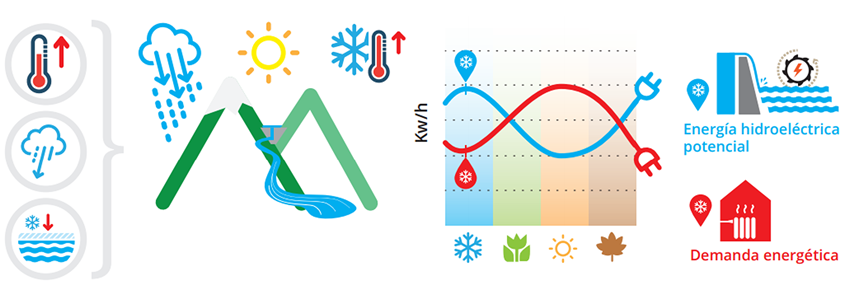The impact of climate change on the hydrological cycle may affect the capacity of hydroelectrical plants to produce power at certain times of year.

Changes in the precipitation regime and thaw dates affect the accumulation capacity of the reservoirs used to produce hydroelectricity.
The droughts of 2003, 2005, 2007 and 2012 led to considerable reductions in hydroelectricity production in the Ebro basin and the Haute-Garonne.
The early snow melt, caused by the high temperatures, is ahead of the spring peak flow rate of the Pyrenean rivers. This situation often means that many reservoirs fill up during rainy seasons.
Solar power production could be favoured in the future by an increase of the solar radiation index throughout the Pyrenees mountain range.
The expected changes in cloud formation and steam in the atmospheric caused by climate change may derive from an increase in total solar radiation, with positive effects on solar energy production.
The potential production capacity of photovoltaic energy could rise by 10% in the mid-century in relation to the current capacity.
However, this increase could be altered by the rising temperatures, which negatively affects photovoltaic systems, and by the damage caused by extreme weather events.
Wind power production could be negatively affected by climate change over the coming decades.
The changes expected in wind patterns and the reduction of their average speed at ground level (up to 9% slower) could reduce the potential production by around -1 MWh/day in relation to current values and over the course of this century.
Seasonal demand for energy is likely to vary considerably over the coming decades due to rising average temperatures and heatwaves.
Increasingly mild winters and warmer summers marked by heatwaves have led to changes in the structure of energy demand for heating and cooling.
It is very probable that energy demand will increase in the coming years to meet the growing need for cooling in summer (peak demand).
This increased demand could coincide with the time when the ability to generate hydroelectricity is lower die to the typical summer droughts and the growing demand for water for other uses (agriculture and human consumption).
If heatwaves become more frequent and intense, as is predicted by the main models, peak demand periods in summer could also become more intense and create problems of supply and conflict with the agricultural sector.
Energy production and transport infrastructure could be affected by the expected increase in natural hazards.

Many of the energy infrastructures and power transmission and transformation systems on both sides of the Pyrenees are particularly exposed to climatic risks and the natural hazards they cause or exacerbate.
Recommendations:
- Diversifying energy sources, prioritising renewable energy.
- Fomenting transition to a model of renewable energy generation and distribution, replacing the current model of centralised production.
- Optimising the use of water resources in the production of hydroelectricity and thermal energy.
- Adapting the management of the energy sector to possible variations in demand.
- Encouraging the rational use of energy in all the socio-economic sectors of the Pyrenees, especially in peak tourism periods.
- Investigate the potential limitations of the current energy system for dealing with climate challenges.
- Ensuring the distribution network has a good capacity for response and recovery in extreme climate events.
PYRENEAN CLIMATE CHANGE OBSERVATORY
Avenida Nuestra Señora de la Victoria, 8
22.700 - Jaca
Huesca - España
+34 974 36 31 00
info_opcc@ctp.org




